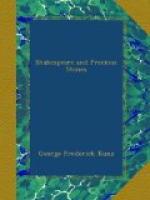As fresh-colored lips are likened to rubies, so it is said of a bright eye, that it “would emulate the diamond” (Merry Wives of Windsor, Act iii, sc. 3).
Bright eyes are also compared to rock-crystal, and the setting of other gems within a bordering of crystals is evidently alluded to in the following lines from Love’s Labour’s Lost (Act ii, sc. 1):
Methought all his senses were
lock’d in his eyes
As jewels in crystal.
First Folio, “Comedies”, p. 128,
col. A, line 7.
We have in Richard II (Act i, sc. 2) the terms “fair and crystal” applied to a clear sky, and in Romeo and Juliet (Act i, sc. 2) the word is used to denote superlative excellence, where a lady’s love is to be weighed against her rival on “crystal scales”.
Rock-crystal was much more highly valued in the England of Elizabeth and of James I than it is to-day, and was freely used as an adjunct to more precious material, and still was employed to some extent in the adornment of book-covers, although this usage, so common in mediaeval times, was fast passing away.
In Shakespeare’s poems, “Venus and Adonis” (1593) and “Lucrece” (1594), as well as in his “Sonnets” (1609), in the “Lover’s Complaint” and in the almost certainly spurious “Passionate Pilgrim”, containing two sonnets and three poems from Love’s Labour’s Lost, and which has been included in most collections of his works, there are perhaps relatively more frequent mentions of precious stones than in the plays, a few of them being of special interest. Where we have twice “ruby lips” (and once “coral lips”) in the plays, the poems speak thrice of “coral lips” or a “coral mouth";[4] a belt has “coral clasps” ("Passionate Pilgrim”, l. 366). This belt bears also “amber studs”, and in the “Lover’s Complaint”, l. 37, are “favours of amber”, and also of “crystal, and of beaded jet”.
[Footnote 4: “Venus and Adonis”, l. 542; “Lucrece”, l. 420; Sonnet cxxx, l. 2.]
Coming to the really precious stones, sapphire finds a single mention, also in the “Lover’s Complaint”, l. 215, where it is termed “heaven-hued”. The same poem says of the diamond that it was “beautiful and hard” (l. 211), thus symbolizing a heartless beauty. More interesting are the following lines regarding the emerald (213, 214):
The deep-green
emerald, in whose fresh regard
Weak sights their
sickly radiance do amend.




